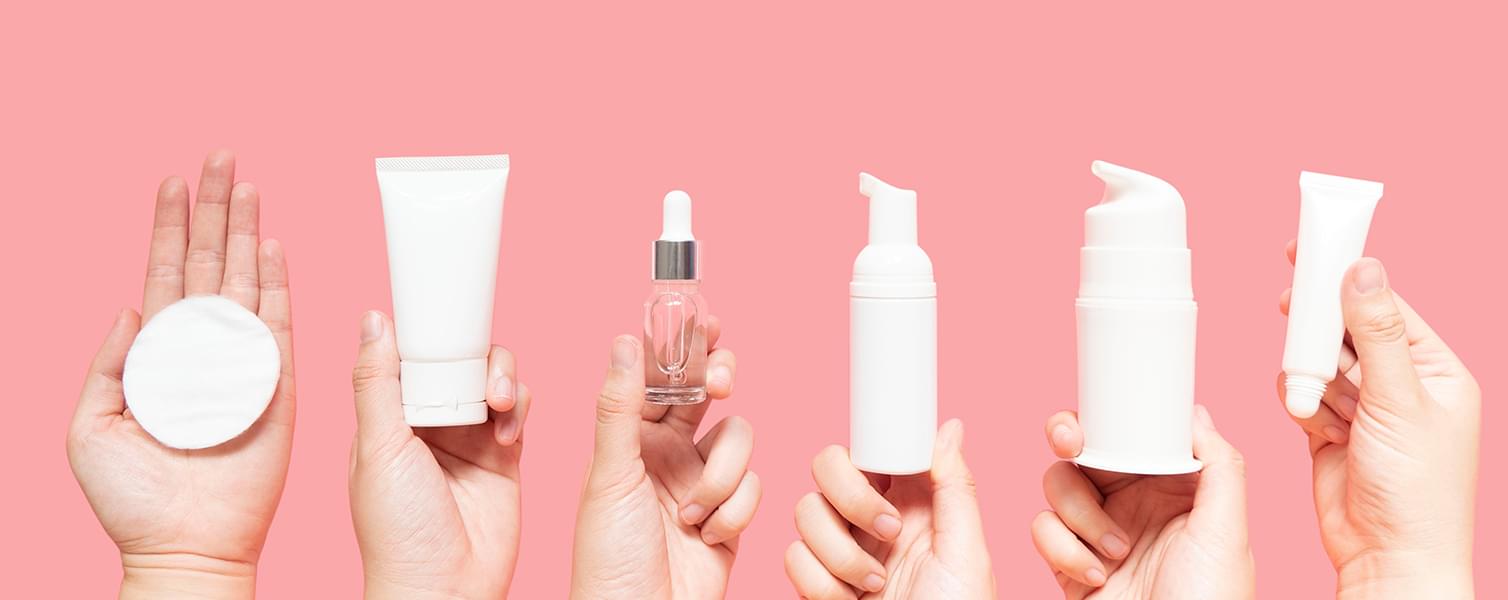Understanding your skin care concerns and how to best address them when using the right skin care products requires that you establish a good skin care regimen and order. It can be challenging to comprehend what each type of skin care product does and how/when to apply them to your skin for the greatest effects given the wide variety available. The distinction between a morning skin care routine order and a nighttime skin care routine order should also be noted.
We asked dermatologists to assist Dermstore establish the appropriate way to apply skin care products and how to develop a suitable skin care routine in order to have that radiant skin we all desire in order for you to get the greatest effects out of your skin care products.
For more information on how to order a morning vs. nighttime skin care routine, read on or check out our infographic: How to Use Your Skin Care Products in the Best Order.
Sponsered4
Why the Order of Your Skin Care Routine Matters
We asked dermatologists to assist Dermstore establish the appropriate way to apply skin care products and how to develop a suitable skin care routine in order to have that radiant skin we all desire in order for you to get the greatest effects out of your skin care products.
For more information on how to order a morning vs. nighttime skin care routine, read on or check out our infographic: How to Use Your Skin Care Products in the Best Order
Sponsered4
The Basics of Any Skin Care Routine
Some experts agree that it’s crucial to take into account the time it takes for your skin to absorb your products in addition to the order of application. Dr. Rogers is aware that this isn’t always feasible because most of us are frequently pressed for time and need to get somewhere—or to bed—as quickly as possible. she gave? Keep your skincare regimen straightforward.
“Many products advise waiting five to thirty minutes before moving on to the next stage in order to ensure full absorption, but who has time for that? You simply won’t do anything if you make it too difficult, according to Dr. Rogers. “If there are several processes, take a little break (about a minute) to give each product time to interact with the skin. For instance, at night, I simply wrap up my day and go to bed after washing my face and applying my serum or nighttime treatment.
Sponsered4
Another word of caution? Check in with your skin. Keep in mind that no one else has your skin and that you are unique. Regardless of what specialists recommend, it’s crucial to identify what works for you and always treat your skin gently.
Why Order Matters, How to Stack Your Skin Care Items, and How to Do It
So which product goes on top of what, you ask? Applying goods from the thinnest consistency to the thickest, or from liquid to cream, is a simple rule of thumb to remember. “Think thin-to-thick generally, but you also want to use first the products with the ingredients that are most important to penetrate the skin (like antioxidants in serums) and finish with the products that need to sit on top of the skin (like emollients and humectants in moisturizers),” advises Dr. Rogers.
A Step-by-Step Guide to Your Daytime Skincare Routine
Sponsered4
Dr. Rogers advises saving your peel pads and therapy products like retinol for the evening because the morning routine is all about protecting your skin from the sun, pollution, and the elements.
STEP 1: CLEANSER
Start washing your face in the morning with warm water or, if necessary, a mild face wash made for your skin type.
Sponsered4
STEP 2: TONER
Due in part to the persistent belief that most toners are harsh and irritate the skin, most individuals opt to forgo using them. Thankfully, that’s no longer the case. The new generation of toners can work as a delivery method for antioxidants, vitamin-B derivatives, and even toning acids while not actually “shrinking” pores. It’s vital to apply the appropriate toner for your skin condition because each type of toner is designed to address a distinct skin problem.
Dr. Rogers advises against starting to use a toner if you have never done so and your skin appears to be in good health. According to Dr. Rogers, strong soaps caused the skin’s pH to become overly basic, which is why toners were developed to help restore it. Toners are no longer a necessary step for me because face cleansers are so much more well-balanced today. Yet, there is no harm in staying with a toner if you enjoy using it.
Sponsered4
STEP 3: ANTIOXIDANT SERUM
Keep serums as close to the skin as you can because they are highly concentrated, nutrient-dense therapies that target specific issues. Although there are many serums on the market today, Dr. Rogers advises using antioxidant serums during the day since they have a number of advantages, including reducing skin inflammation and repairing damage from UV radiation and environmental toxins.
STEP 4: EYE CREAM
Sponsered4
Starting in your 20s, it’s crucial to use an eye cream at least every night, if not twice a day, says dermatologist Dr. Annie Chiu. “It’s about preserving the elasticity and thickness of the skin on the eyelids. Early skin quality improvement makes it less likely that the eyelid skin will subsequently lose its suppleness and smooth appearance.
Consistency is essential for the finest outcomes. “Over time, consistent usage of eye cream will maintain the eyelid skin supple and can reduce or avoid some fine wrinkles and collagen loss. Recall that nothing is magical. Outcomes take time to manifest, Dr. Chiu notes. By selecting an eye cream with SPF or using sunscreen every day, you can further protect the delicate skin around your eyes. Also, Dr. Chiu suggests wearing sunglasses outside to guard against UV damage and wrinkles that can form around the corners of your eyes from squinting.
STEP 5: SPOT TREATMENT
Sponsered4
Prescription drugs and acne spot treatments should be applied as closely to the skin as possible, says Rosacea Treatment Center dermatologist Dr. Diane De Fiori, to maximize their effects.
For the optimum application technique, read the product box or speak with your doctor as active components in acne spot treatments vary. According to esthetician and acne specialist Ashley Wiley, prescription-strength benzoyl peroxide has a one- to three-hour working duration. This is a typical element in acne spot treatments. Any cream that touches it before it has finished working will probably prevent the active component from performing as intended.
Always apply acne spot treatments only where you need them because they can dry out your skin.
Sponsered4
STEP 6: MOISTURIZER
For the optimum application technique, read the product box or speak with your doctor as active components in acne spot treatments vary. According to esthetician and acne specialist Ashley Wiley, prescription-strength benzoyl peroxide has a one- to three-hour working duration. This is a typical element in acne spot treatments. Any cream that touches it before it has finished working will probably prevent the active component from performing as intended.
Always apply acne spot treatments only where you need them because they can dry out your skin.
Sponsered4
If you’re using an acne spot treatment, you may want to skip those areas when applying your moisturizer to make sure the ingredients in it won’t interfere with the active ingredients in your spot treatment.
Step 7: SUNSCREEN
If you use a physical or mineral sunscreen, which blocks UV rays physically, it should come last in your daytime skin care regimen. When applying a chemical sunscreen, this procedure gets challenging.
Sponsered4
Dr. Rogers explains: “Applying chemical sunscreens after your moisturizer will delay and hamper that because they need to be absorbed into the skin to be effective. Yet, because the skin is already covered with chemical sunscreen if you apply your chemical sunscreen first, your moisturizer won’t function as effectively either.
Dr. Rogers suggests using a zinc-containing physical sunscreen and applying it after your moisturizer to get around this. The largest UVA and UVB protection is offered by zinc, which is also safe and effective.
For those who prefer chemical sunscreens, try to look for a formula that also has moisturizing properties so you can obtain your daily needs of hydration while also protecting your skin.
Sponsered4
How to Take Care of Your Skin at Night: A Step-by-Step Guide
According to Dr. Rogers, your evening routine should focus entirely on treating and providing your skin with what it needs because your skin naturally repairs itself at night. “Exfoliate if your skin is looking dull. Hydrate and protect if it is inflamed. To ensure you get the maximum benefit from your skin care products, follow this recommended order:
STEP 1: (DOUBLE) CLEANSER
Sponsered4
To get rid of the day’s grime, dirt, oil and makeup, some experts recommend removing your makeup first with a dedicated makeup remover before washing your face with a gentle cleanser. Better yet, try double cleansing, which involves using a cleansing oil first to dissolve your makeup and then washing your face again with your regular cleanser.
STEP 2: TONERS, ESSENCES AND BOOSTERS
Apply a toner like you would in the morning if you choose to use one.
Sponsered4
Some people enjoy layering different skin care boosters at night. These boosters can take the form of mists, essences, beauty waters, or moisturizing (hyaluronic acid) serums. They contain a variety of active substances, but their primary function is to moisturize and nourish skin.
Use these after washing your face as you would a toner because these are thin, almost water-like compositions. If using both, Dr. Rogers advises using toner first and then essence. “Toner is more for cleaning, while essence is more for treating,” The same guidelines still apply if you’re using numerous boosters: use them in order of thickness.
STEP 3: EYE CREAM
Sponsered4
Eye creams help protect your delicate eye area from other skin care products in addition to treating crow’s feet and dark circles.
According to Dr. Rogers, you should often apply your eye cream prior to treatments to shield your eye area from strong substances that can cause irritation.
STEP 4: TREATMENTS, SERUMS AND PEELS
Sponsered4
Similar to the rest of the body, the majority of skin’s mending, restoring, and regenerating occurs while we sleep. Because of this, it is recommended to use the majority of targeted skin care products at night, including prescription medications (such as tretinoin, acne and rosacea creams), retinol creams, exfoliating treatments (such as peel pads and masks), and anti-aging serums (containing peptides, growth factors, and other biologically active ingredients). Dr. Rogers advises picking your nightly treatment based on your skin’s current needs rather than piling up all of your treatment serums and creams.
According to Dr. Rogers, taking too many steps merely raises the possibility of discomfort and lowers the likelihood of achieving the intended outcome. Choose your nighttime skincare regimen based on what your skin requires that night, not what is in your medical cabinet. Sometimes, all you do is bathe, moisturize, and go to bed. There is always tomorrow to continue to appreciate your skin.
Here are other considerations:
Sponsered4
- Choose between prescription meds (for acne or rosacea) OR exfoliative treatments (like AHA/BHA pads, peels or detoxifying masks). “If you use both on the same night, you significantly increase your risk of irritating your skin,” warns Dr. Rogers.
- Don’t use retinol creams (over the counter or prescription) on the same night as exfoliative treatments, either.
- Exfoliative treatments: Use these sparingly, one to three times a week.
STEP 5: MOISTURIZER OR NIGHT CREAM
Some people apply the same moisturizer at night and during the day. However, night creams or moisturizers are typically heavier and thicker and are meant to be absorbed gradually over a period of several hours.
According to Dr. Rogers, moisturizer, especially the heavier kind applied at night, forms a shield over the skin to stop water evaporation as you sleep. “The key to mending and preserving healthy skin is having a high water content in the skin. As nothing will pass through it if you are using the appropriate moisturizer, it should be your final step. You might wish to add a face oil if your skin is really dry before using your night cream.
Sponsered4
Skin Care Routine Steps
Need a quick reference on how to go about your skin care routine? Check out our ultimate cheat sheet below.
Sponsered4




